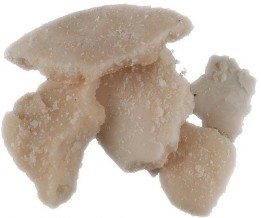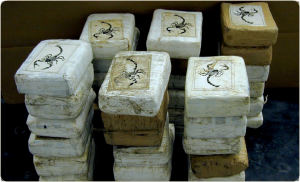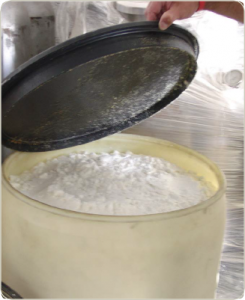3.4 Stimulants
What are Stimulants?
Stimulants speed up the body’s systems. This class of drugs includes: Prescription drugs such as amphetamines [Adderall and dexedrine], Methylphenidate [Concerta and Ritalin], diet aids [such as Didrex, Bontril, Preludin, Fastin, Adipex P, ionomin, and Meridia] and illicitly produced drugs such as methamphetamine, cocaine, and methcathinone. The stimulant nicotine will be covered in the next section.
What is their Origin?
Stimulants are diverted from legitimate channels and clandestinely manufactured exclusively for the ilicit market.

What are Common Street Names?
Common street names for stimulants include:
-
Bennies, Black Beauties, Cat, Coke, Crank, Crystal, Flake, Ice, Pellets, R-Ball, Skippy, Snow, Speed, Uppers, and Vitamin R.
What do They Look Like?
Stimulants come in the form of pills, powder, rocks, and injectable liquids.
How are they Abused?
Stimulants can be pills or capsules that are swallowed. Smoking, snorting, or injecting stimulants produces a sudden sensation known as a “rush” or a “flash.” Abuse is often associated with a pattern of binge use — sporadically consuming large doses of stimulants over a short period of time. Heavy users may inject themselves every few hours, continuing until they have depleted their drug supply or reached a point of delirium, psychosis, and physical exhaustion. During heavy use, all other interests become secondary to recreating the initial euphoric rush.
What is Their Effect on the Mind?
When used as drugs of abuse and not under a doctor’s supervision, stimulants are frequently taken to:
- Produce a sense of exhilaration, enhance self-esteem, improve mental and physical performance, increase activity, reduce appetite, extend wakefulness for a prolonged period, and “get high”
- Chronic, high-dose use is frequently associated with agitation, hostility, panic, aggression, and suicidal or homicidal tendencies.
- Paranoia, sometimes accompanied by both auditory and visual hallucinations, may also occur.
- Tolerance, in which more and more drug is needed to produce the usual effects, can develop rapidly, and psychological dependence occurs. In fact, the strongest psychological dependence observed occurs with the more potent stimulants, such as amphetamine, methylphenidate, methamphetamine, cocaine, and methcathinone.
Abrupt cessation is commonly followed by depression, anxiety, drug craving, and extreme fatigue, known as a “crash”.
What is Their Effect on the Body?
Stimulants are sometimes referred to as uppers and reverse the effects of fatigue on both mental and physical tasks. Therapeutic levels of stimulants can produce exhilaration, extended wakefulness, and loss of appetite. These effects are greatly intensified when large doses of stimulants are taken. Taking too large a dose at one time or taking large doses over an extended period of time may cause such physical side effects as dizziness, tremors, headache, flushed skin, chest pain with palpitations, excessive sweating, vomiting, and abdominal cramps.
What are Their Overdose Effects?
In overdose, unless there is medical intervention, high fever, convulsions, and cardiovascular collapse may precede death. Because accidental death is partially due to the effects of stimulants on the body’s cardiovascular and temperature-regulating systems, physical exertion increases the hazards of stimulant use.
Which Drugs cause Similar Effects?
Some hallucinogenic substances, such as ecstasy, have a stimulant component to their activity.
What is Their Legal Status in the United States?
A number of stimulants have no medical use in the United States but have a high potential for abuse. These stimulants are controlled in Schedule I. Some prescription stimulants are not controlled, and some stimulants like tobacco and caffeine don’t require a prescription — though society’s recognition of their adverse effects has resulted in a proliferation of caffeine-free products and efforts to discourage cigarette smoking.
Stimulant chemicals in over-the-counter products, such as ephedrine and pseudoephedrine, can be found in allergy and cold medicine. As required by The Combat Methamphetamine Epidemic Act of 2005, a retail outlet must store these products out of reach of customers, either behind the counter or in a locked cabinet. Regulated sellers are required to maintain a written or electronic form of a logbook to record sales of these products. In order to purchase these products, customers must now show a photo identification issued by a state or federal government. They are also required to write or enter into the logbook: their name, signature, address, date, and time of sale. In addition to the above, there are daily and monthly sales limits set for customers.
Amphetamines
What are Amphetamines?
Amphetamines are stimulants that speed up the body’s system. Many are legally prescribed and used to treat attention-deficit hyperactivity disorder (ADHD).
What is Their Origin?
Amphetamine was first marketed in the 1930s as Benzedrine in an over-the-counter inhaler to treat nasal congestion. By 1937 amphetamine was available by prescription in tablet form and was used in the treatment of the sleeping disorder narcolepsy and ADHD. Over the years, the use and abuse of clandestinely produced amphetamines have spread. Today, clandestine laboratory production of amphetamines has mushroomed, and the abuse of the drug has increased dramatically.
What are Common Street Names?
Common street names include: Bennies, Black Beauties, Crank, Ice, Speed, and Uppers.
What do they Look Like?
Amphetamines can look like pills or powder. Common prescription amphetamines include methylphenidate (Ritalin or Ritalin SR), amphetamine and dextroamphetamine (Adderall), and dextroamphetamine (Dexedrine).
How are they Abused?
Amphetamines are generally taken orally or injected. However, the addition of “ice,” the slang name of crystallized methamphetamine hydrochloride, has promoted smoking as another mode of administration. Just as “crack” is smokable cocaine, “ice” is smokable methamphetamine.
What is their Effect on the Mind?
The effects of amphetamines and methamphetamine are similar to cocaine, but their onset is slower and their duration is longer. In contrast to cocaine, which is quickly removed from the brain and is almost completely metabolized, methamphetamine remains in the central nervous system longer, and a larger percentage of the drug remains unchanged in the body, producing prolonged stimulant effects.
Chronic abuse produces a psychosis that resembles schizophrenia and is characterized by paranoia, picking at the skin, preoccupation with one’s own thoughts, and auditory and visual hallucinations. Violent and erratic behavior is frequently seen among chronic users of amphetamines and methamphetamine.
What is their Effect on the Body?
Physical effects of amphetamine use include increased blood pressure and pulse rates, insomnia, loss of appetite, and physical exhaustion.
What are their Overdose Effects?
Overdose effects include agitation, increased body temperature, hallucinations, convulsions, and possible death.
Which Drugs Cause Similar Effects?
Drugs that cause similar effects include dexmethylphenidate, phentermine, benzphetamine, phendimetrazine, cocaine, crack, methamphetamine, and khat.
What is their Legal Status in the United States?
Amphetamines are Schedule II stimulants, which means that they have a high potential for abuse and a currently accepted medical use (in FDA-approved products). Pharmaceutical products are available only through a prescription that cannot be refilled.
Cocaine
What is Cocaine?
Cocaine is an intense, euphoria-producing stimulant drug with strong addictive potential.
What is its Origin?
Cocaine is derived from coca leaves grown in Bolivia, Peru, and Colombia. The cocaine manufacturing process takes place in remote jungle labs where the raw product undergoes a series of chemical transformations. Colombia produces about 90 percent of the cocaine powder reaching the United States. Most of the cocaine entering the United States comes through Mexico.
What are Common Street Names?
Common street names include: Coca, Coke, Crack, Flake, Snow, and Soda Cot.
What does it Look Like?
Cocaine is usually distributed as a white, crystalline powder. Cocaine is often diluted (“cut”) with a variety of substances, the most common of which are sugars and local anesthetics. It is “cut” to stretch the amount of the product and increase profits for dealers. In contrast, cocaine base (crack) looks like small, irregularly shaped chunks (or “rocks”) of a whitish solid.
How is it Abused?
Powdered cocaine can be snorted or injected into the veins after dissolving in water. Cocaine base (crack) is smoked, either alone or on marijuana or tobacco. Cocaine is also used in combination with an opiate, like heroin, a practice known as “speedballing.” Although injecting into veins or muscles, snorting, and smoking are the common ways of using cocaine, all mucous membranes readily absorb cocaine. Cocaine users typically binge on the drug until they are exhausted or run out of cocaine.

What is its Effect on the Mind?
The intensity of cocaine’s euphoric effects depends on how quickly the drug reaches the brain, which depends on the dose and method of abuse. Following smoking or intravenous injection, cocaine reaches the brain in seconds, with a rapid buildup in levels. This results in a rapid-onset, intense euphoric effect known as a “rush”.
By contrast, the euphoria caused by snorting cocaine is less intense and does not happen as quickly due to the slower build-up of the drug in the brain. Other effects include increased alertness and excitation, as well as restlessness, irritability, and anxiety.
Tolerance to cocaine’s effects develops rapidly, causing users to take higher and higher doses. Taking high doses of cocaine or prolonged use, such as binging, usually causes paranoia. The crash that follows euphoria is characterized by mental and physical exhaustion, sleep, and depression lasting several days. Following the crash, users experience a craving to use cocaine again.
What is its Effect on the Body?
Physiological effects of cocaine include increased blood pressure and heart rate, dilated pupils, insomnia, and loss of appetite. The widespread abuse of highly pure street cocaine has led to many severe adverse health consequences such as cardiac arrhythmias, ischemic heart conditions, sudden cardiac arrest, convulsions, strokes, and death. In some users, the long-term use of inhaled cocaine has led to a unique respiratory syndrome, and chronic snorting of cocaine has led to the erosion of the upper nasal cavity.
Which Drugs cause Similar Effects?
Other stimulants, such as methamphetamine, cause effects similar to cocaine that vary mainly in degree.
What is its Legal status in the United States?

Cocaine is a Schedule II drug under the Controlled Substances Act, meaning it has a high potential for abuse and has an accepted medical use for treatment in the United States.
Hydrochloride solution (4 percent and 10 percent) is used primarily as a topical local anesthetic for the upper respiratory tract. It also is used to reduce bleeding of the mucous membranes in the mouth, throat, and nasal cavities. However, better products have been developed for these purposes, and cocaine is rarely used medically in the United States.
Khat
What is Khat?
Khat is a flowering evergreen shrub that is abused for its stimulant-like effect. Khat has two active ingredients, cathine, and cathinone.
What is its Origin?
Khat is native to East Africa and the Arabian Peninsula, where the use of it is an established cultural tradition for many social situations.

What does it Look Like?
Khat is a flowering evergreen shrub. Khat that is sold and abused is usually just the leaves, twigs, and shoots of the Khat shrub.
How is it Abused?
Khat is typically chewed like tobacco, then retained in the cheek and chewed intermittently to release the active drug, which produces a stimulant-like effect. Dried Khat leaves can be made into a tea or a chewable paste, and Khat can also be smoked and even sprinkled on food.
What is its Effect on the Mind?
Khat can induce manic behavior with grandiose delusions, paranoia, nightmares, hallucinations, and hyperactivity. Chronic Khat abuse can result in violence and suicidal depression.
What is its Effect on the Body?
Khat causes an immediate increase in blood pressure and heart rate. Khat can also cause a brown staining of the teeth, insomnia, and gastric disorders. Chronic abuse of Khat can cause physical exhaustion. The dose needed to constitute an overdose is not known, however, it has been historically associated with those who are long-term chewers of the leaves. Symptoms of toxicity include delusions, loss of appetite, difficulty with breathing, and increases in both blood pressure and heart rate. Additionally, there are reports of liver damage (chemical hepatitis) and cardiac complications; specifically myocardial infarctions. This mostly occurs among long-term chewers of khat or those who have chewed too large a dose.
Which Drugs cause Similar Effects?
Khat’s effects are similar to other stimulants, such as cocaine, amphetamine, and methamphetamine.
What is its Legal Status in the United States?
The chemicals found in khat are controlled under the Controlled Substances Act. Cathine is a Schedule IV stimulant, and cathinone is a Schedule I stimulant under the Controlled Substances Act, meaning that it has a high potential for abuse, no currently accepted medical use in treatment in the United States, and a lack of accepted safety for use under medical supervision.
Methamphetamine
What is Methamphetamine?
Methamphetamine (meth) is a stimulant. The FDA- approved brand-name medication is Desoxyn.
What is its Origin?
Mexican drug trafficking organizations have become the primary manufacturers and distributors of methamphetamine to cities throughout the United States, including in Hawaii. Domestic clandestine laboratory operators also produce and distribute meth but usually on a smaller scale. The methods used depend on the availability of precursor chemicals.
Currently, this domestic clandestinely produced meth is mainly made with diverted products that contain pseudoephedrine. Mexican methamphetamine is made with different precursor chemicals. The Combat Methamphetamine Epidemic Act of 2005 requires retailers of non-prescription products containing pseudoephedrine, ephedrine, or phenylpropanolamine to place these products behind the counter or in a locked cabinet. Consumers must show identification and sign a logbook for each purchase.
What are Common Street Names?
Common street names include Batu, Bikers Coffee, Black Beauties, Chalk, Chicken Feed, Crank, Crystal, Glass, Go-Fast, Hiropon, Ice, Meth, Methlies Quick, Poor Man’s Cocaine, Shabu, Shards, Speed, Stove Top, Tina, Trash, Tweak, Uppers, Ventana, Vidrio, Yaba, and Yellow Bam.
What does it Look Like?
Regular meth is a pill or powder. Crystal meth resembles glass fragments or shiny blue-white “rocks” of various sizes.
How is it Abused?
Meth is swallowed, snorted, injected, or smoked.

To intensify the effects, users may take higher doses of the drug, take it more frequently, or change their method of intake.
What is its effect on the mind?
Meth is a highly addictive drug with a potent central nervous system (CNS) stimulant properties.
Those who smoke or inject it report a brief, intense sensation, or rush. Oral ingestion or snorting produces a long-lasting high instead of a rush, which reportedly can continue for as long as half a day. Both the rush and the high are believed to result from the release of very high levels of the neurotransmitter dopamine into areas of the brain that regulate feelings of pleasure. Long-term meth use results in many damaging effects, including addiction.
Chronic meth users can exhibit violent behavior, anxiety, confusion, insomnia, and psychotic features including paranoia, aggression, visual and auditory hallucinations, mood disturbances, and delusions such as the sensation of insects creeping on or under the skin. Such paranoia can result in homicidal or suicidal thoughts. Researchers have reported that as much as 50 percent of the dopamine-producing cells in the brain can be damaged after prolonged exposure to relatively low levels of meth. Researchers also have found that serotonin-containing nerve cells may be damaged even more extensively.
What is its Effect on the Body?
Taking even small amounts of meth can result in increased wakefulness, increased physical activity, decreased appetite, rapid breathing and heart rate, irregular heartbeat, increased blood pressure, and hyperthermia (overheating). High doses can elevate body temperature to dangerous, sometimes lethal, levels, and cause convulsions and even cardiovascular collapse and death. Meth use may also cause extreme anorexia, memory loss, and severe dental problems.
What are its Overdose Effects?
High doses may result in death from stroke, heart attack, or multiple organ problems caused by overheating.
Which Drugs cause Similar Effects?
Cocaine and potent stimulant pharmaceuticals, such as amphetamines and methylphenidate, produce similar effects.
What is its Legal status in the United States?
Methamphetamine is a Schedule II stimulant under the Controlled Substances Act, which means that it has a high potential for abuse and a currently accepted medical use (in FDA-approved products). It is available only through a prescription that cannot be refilled. Today there is only one legal meth product, Desoxyn. It is currently marketed in 5-milligram tablets and has very limited use in the treatment of obesity and attention deficit hyperactivity disorder (ADHD).
Source: Drugs of Abuse: A DEA resource guide (DEA, 2017)
Frontline – The Meth Epidemic
Watch this 53-minute film and explore the accompanying website. While the meth epidemic has been taken over by the opioid epidemic, this film makes it clear how drug epidemics spread as well as ebb and flow.
For additional information, see National Institute on Drug Abuse (NIDA), Methamphetamine.


